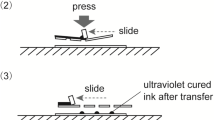Abstract
Many researchers indicate the importance of temporal aspects of braille reading (Grunwald, 1966; Millar, 1987).The purpose of this study was to determine whether braille pattern recognition depends on finger movement speed using a learning transfer paradigm. The participants performed the braille recognition task during nine blocks under one finger movement speed condition, and were then tested under the other finger movement speed. The results of this experiment demonstrate that training enhances the performance in spite of finger movement speed. Even if a participant experiences training in the fast condition, performance in the slow condition is improved. Thus, this result is suggested that Braille pattern recognition does not depend on finger movement speed.
Access this chapter
Tax calculation will be finalised at checkout
Purchases are for personal use only
Preview
Unable to display preview. Download preview PDF.
Similar content being viewed by others
References
Chapman, C.E.: Active versus passive touch: factors influencing the transmission of somatosensory signals to primary somatosensory cortex. Canadian Journal of Physiology and Pharmacology 72, 558–570 (1994)
Meftah, E.M., Belingard, L., Chapman, C.E.: Relative effects of the spatial and temporal characteristics of scanned surfaces on human perception of tactile roughness using passive touch. Experimental Brain Research 132, 351–361 (2000)
Lederman, S.J.: Tactile roughness of grooved surfaces: the touching process and effects of macro- and microsurface structure. Perception and Psychophysics 16, 385–395 (1974)
Grunwald, A.P.: A braille reading machine. Science 154, 144–146 (1966)
Millar, S.: Perceptual and task factors in fluent braille. Perception 16(4), 521–536 (1987)
Author information
Authors and Affiliations
Editor information
Editors and Affiliations
Rights and permissions
Copyright information
© 2012 Springer-Verlag Berlin Heidelberg
About this paper
Cite this paper
Oshima, K., Ichihara, S. (2012). How Finger Movement Speed Affects Braille Pattern Recognition. In: Isokoski, P., Springare, J. (eds) Haptics: Perception, Devices, Mobility, and Communication. EuroHaptics 2012. Lecture Notes in Computer Science, vol 7283. Springer, Berlin, Heidelberg. https://doi.org/10.1007/978-3-642-31404-9_20
Download citation
DOI: https://doi.org/10.1007/978-3-642-31404-9_20
Publisher Name: Springer, Berlin, Heidelberg
Print ISBN: 978-3-642-31403-2
Online ISBN: 978-3-642-31404-9
eBook Packages: Computer ScienceComputer Science (R0)




